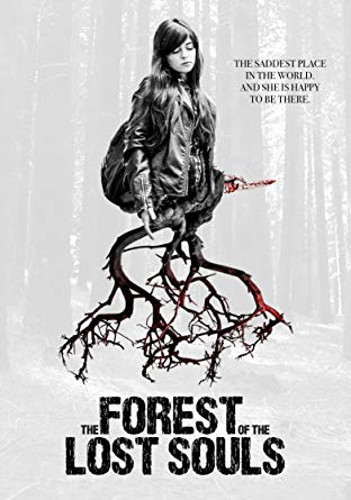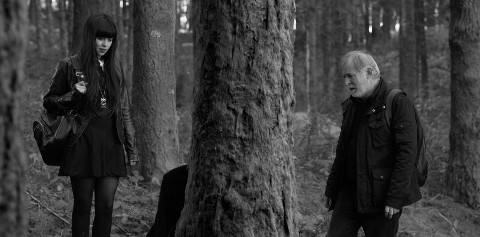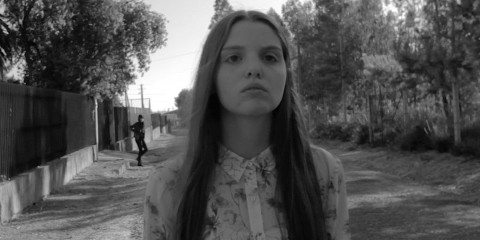The Forest of the Lost Souls (2017)
Directed by: José Pedro Lopes
Written by: José Pedro Lopes
Starring: Daniela Love, Jorge Mota, Lígia Roque, Mafalda Banquart
AKA A FLORESTA DAS ALMAS PERDIDASA
Portugal
AVAILABLE ON DVD AND AMAZON PRIME, from SHARPTEETHFILMS
RUNNING TIME: 69 mins
REVIEWED BY: Dr Lenera, Official HCF Critic
In Portugal is the Forest of the Lost Souls, a place where many people go to commit suicide. The latest visitors to the place are Ricardo and Caroline. Ricardo has been a wreck since his daughter drowned herself in the lake of the same forest and, feeling responsible and unable to support his surviving family, is intent on finding a nice spot to stab himself to death. However, the spot he chooses has also been chosen by the much younger Caroline. She often comes to the forest to end her existence, but so far hasn’t gone through with it. She also likes to photograph visitors who are about to do the need. The two become fascinated with each other as they explore the forest. However, one of them has a deadly secret….
We have a ridiculously large backlog of digital screeners to get through, so with a break in physical screeners and me desiring to watch and review something that I’d hopefully never heard of, I decided to shut my eyes and see which film in the list my finger rested on. This Portuguese oddity, even before I began to watch it, seemed like it was going to be a much artier effort than stuff like The Mummy Reborn and Clownado, both of which had caught my eye when I briefly browsed the list a few days before. And maybe I’ll do those another time. But for now we have The Forest Of The Lost Souls. While the story does connect up, it comes across very much as a film of two halves, with for me the more contemplative first half being more interesting than the second which is much more in the slasher vein. I’m in no way trying to suggest that I don’t like things such as psychopathic killers stalking potential victims and home invasions. I do, and writer/director José Pedro Lopes proves himself to be pretty good at this kind of thing despite only having a very meagre budget at his disposal. But this stuff is a dime a dozen, while you don’t often see films, and certainly in the horror genre, that look seriously at that terrible thing called suicide and have characters continually discuss it. Yes, it’s formed the plot of countless genre movies and has quite often been the cause of terror that we witness, there havfe been satirical efforts like Japan’s Suicide Club, and 2016’s The Forest was even set in Japan’s equivalent of the forest in this film. And, lest we forget [though most try to], we’ve also had The Happening. But the direct and realistic examination of suicide in the first half of this film is something I’d never seen before in a horror movie and therefore appreciated, however depressing it might be, though Lopes does feel able to give us a few minor laughs without coming across as crass. However, once the second half comes along it almost reduces the first half to feeling little more than a very lengthy, wordy preamble, and the expectation that the film is going to go really deep is not fulfilled.
However, let’s not try to get too negative, because there’s quite a lot to admire here. Of course, you’ll probably already know if this subtitled, black and white, 69 minute feature is going to appeal or not. Now I don’t know if the monochrome was an artistic decision – after all, A Girl Walks Home Alone proved how effective a horror film can still be in black and white and The Lighthouse apparently does so too – or something made necessary by a very low budget. However, within seconds, the striking cinematography of Francisco Lobo made me forget about colour. His lensing creates a forest that’s alternately beautiful, mysterious, depressing and creepy, and all without the usual green and brown. Even the opening scene is especially well photographed with terrific and very precise use of the frame. It has an air of terrible sadness as the sound of wind is overheard over shots of piles of heart-shaped lockets, then we hear a young woman’s voice quoting Van Gogh and Nietzsche’s ruminations on suicide. We then see her taking photographs of herself as the song playing in the background gets stuck, just like most of the movie’s characters are stuck in their lives. Cut to her walking about in the forest. to be startled by a dead body in the far distance as the noise of buzzing flies is heard. It doesn’t stop her from walking into the lake though, to eventually fall back and under the water. Without intending to glorify the act of taking one’s life, there’s quite a poetic feel to all this, and a sense of calm and even closure, even though this is of course only the beginning of the film. It reminded me of the ending of The Hours. I’ll say right now though that we never find out why this particular person kills herself, even though we soon realise that the event we’ve witnessed is an important one.
Edgy, vaguely dance-like music over images of papier mache constructions of what you can just about discern are bodies reminds us that this will be a horror film, though of course there isn’t much that’s more horrible than suicide. We’re still in the forest but are now following Ricardo, a middle aged guy who at first seems like he’s just come comfortably backpacking, but after being startled by a female doll hanging from a tree, he sits down by a huge rock, pulls out a knife to do something very stupid with, and then a female voice cries out from on top of the rock, “A little privacy please, with such a big forest you had to pick my spot”. Unsurprisingly they don’t get on very well at first, she not taking kindly to his comment about her being too young to do this, and he annoyed by her mocking of the method with which he’s chosen to off himself, a knife versus the far more practical poison pills, and that he has neither an alternative method nor a suicide note because,“90% of people back out because of no suicide note”. There’s indeed a slight dark comedy aspect to some of their interplay, as there probably would be, without seeming disrespectful to the topic at hand. “You shouldn’t smoke, slow and painful death”, says he to her at one point. At first he seems like the most vulnerable one, and the one we know a little bit more about. He’s come there because of grief and feeling a failure. Her – well, it seems more like an extreme act of teenage rebellion. She says how she frequently visits the forest but never goes through with it. She may just manage it this time, but she has an alibi, of being at a music festival, just in case she still doesn’t follow through and people wonder where she’s been. What with the fine performances from Daniel Love and Jorge Mota, the chemistry between them, the tonally balanced dialogue, and the evocative photographing of the locale, I’d have been happy to sit through another half an hour or so of these two just walking and talking.
However, things suddenly and drastically change, and I’m going to have to be rather vague here so I don’t ruin the surprise. Because I like to waffle more and more and seem to have lost the ability of brevity, I sometimes have a tendency to give plot points away, but I’m not going to do so here so the surprise will hit you hard, unless of course you’ve already guessed it from my synopsis of the first half, something for which I can’t help. However, I wouldn’t be surprised if many reviews do reveal what happens, and to be honest some publicity seems to more than hint at it too. I guess that distributors Wild Eye Releasing [in North America] and SharpTeethFilms [in the UK] felt that they had to alert viewers to the fact that this was still a horror film. In any case, we now switch to Filipa, a teenage girl who’s gone for a bit of a wander without telling her family where she’s gone. Like the previous two characters we’ve spent time with, she’s very troubled, though she doesn’t seem like the type to kill herself. She has a tense relationship with her mother, though there’s a nice little moment where they briefly bond again over the kitchen work surface that feels natural and not out of place in the general tone of the piece. However, what they don’t know is that a black clad killer in a hood has targeted this household. As I mentioned very early on in this review, things are revealed to tie in with each other, but I just missed the more thought provoking nature of the first half, even though here we have a murderous psychopath whose reasoning for killing victims is kind of rational – well, in a twisted way. And you keep thinking that things are going to finish off in the forest back where we were earlier with a big chase through the trees [geography seems a bit off, but I think we’re intended to believe that the house is very near to the forest], but they don’t.
You do get some stalking and slashing, though little detail is shown – in fact even the bodies of people who’ve killed themselves in the forest that Ricardo and Caroline come across are not seen or just partially shown. Though possibly again a budgetary restriction, the latter kind of works, especially in retrospect when you know a lot more. But don’t let this reticence put you off. Lopes has a real knack for this sort of material and I think he’ll be superb at directing a full-on slasher movie. Like so many others, he’s clearly influenced by the original Halloween and sees no shame in hiding it, notably in a bit when Filipa is walking down the street and the killer suddenly appears from behind a corner on the left hand side of the frame to follow her. But many of today’s horror filmmakers could constantly do with being reminded of the fact that loud “BOO!” moments consisting of a sudden cut to something scary and a loud musical chord playing on the soundtrack aren’t everything, that something eerie happening on the side or in the distance that you may only even partly notice can be just as potent. And he plays on the fact that this killer can seem to move about in total silence [is it the shoes?] really well in scenes set inside the house which give us a few terrific “he’s behind you” moments. Of course the cinematography is still top class with some fine use of black, and we are still asked to think a bit – but not nearly so much as we were in the first half of the film. Perhaps the short running time hindered matters a bit. The rather rushed second half being expanded to, say, the second two thirds, might have allowed some of the depth of the first half to remain while still providing the thrills we expect. I wonder if Lopes has ever considered remaking his film if he’s able to get a bigger budget for it – though then he would probably go for shooting it in colour which would result in it losing some of its distinctive feel.
In his first feature, Lopes most certainly shows that he is able to use settings to their best advantage, and seems to be another director in the genre who likes to employ long takes over frantic editing, something that’s most welcome in the eyes of this critic. Emanuel Grácio’s musical score is adept at providing atmospheric synth melodies one moment and growling industrial throbbing for another. There’s so much to appreciate in The Forest Of The Lost Souls that I feel a bit bad for my criticising of the structure and the changes in direction, and I have no doubt that some may not have a problem with them. In the end, we’re still asked to ruminate on suicide, its effect, and the kind of people who would contemplate and do such an awful thing, something not many Hollywood slashers would consider doing. This means that it has a kind of haunting quality that may stay with you for a while.
Rating: 














Be the first to comment